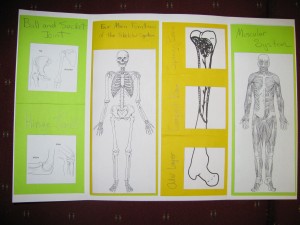I used Great Science Adventures: Discovering the Human Body and Senses from Common Sense Press as the main resource for our recent study of the human body. Overall, I enjoyed this program and plan to use other titles from the Great Science Adventures series in the future.
Before the individual lessons are presented, there is quite a bit of information included at the beginning of the book that I found helpful. The different parts of the curriculum are clearly explained, including how to use the program with children of different ages. There are also several pages that show how to make different kinds of mini-books.
The curriculum is divided into 24 lessons, with each lesson taking 1-3 days to complete depending on the number of activities that are completed. Each lesson is organized in the same way which makes understanding and following the curriculum easy for the teaching parent.
Lesson 1, as in all lessons, is organized in the following manner:
- Human Body Concepts – The main points of the lesson are clearly stated in this section. I found this very helpful when I wanted to add books to our study.
- Vocabulary Words
- Construct and Read – Each lesson uses one of the Lots of Science Library Books. These 24 little books are included in the curriculum but they must be cut apart and constructed prior to the lesson.
- Activities – In this section, clear instructions are given for putting together graphic organizers for the information. Basically, students put together multiple lapbooks over the duration of the course in which to organize the information. Since this is a multi-age program, instructions are given at three different levels.
- Experiences, Investigations, and Research – In this section several suggested ideas are given for hands-on activites, books to read, and websites to visit.
I used this curriculum with my 7th grade daughter, 5th grade son, and 3rd grade son. With the instructions given in the Activities section, I could easily have them all complete the same graphic organizer but write according to their level. For example, in the Bone Parts graphic organizer, the suggested writing for the youngest learner (K-1st grades) is to color the spongy bone, compact bone, and outer layer in different colors. The suggested writing for the primary level (2nd-3rd grades) is to write clue words about each part of the bone. For the oldest learner (4th grade and up) it is suggested that each part of the bone be described along with its function. While I usually have my children work at different levels when completing mini-books for lapbooks, I found it quite helpful to have such specific suggestions for their writing.
While I did like the Lots of Science Library Books, I found I needed to supplement the information in the mini-books with library books and educational videos. Having the main points of each lesson clearly stated at the beginning helped tremendously in easily finding additional support materials either from my own reference books at home or at the library. Rather than make a set of Lots of Science Library Books for each of my children, I made one set to share.
We completed many of the suggested learning activities listed under Experiences, Investigations, and Research but there were many more that we didn’t take the time to pursue. The curriculum could easily be extended beyond the suggested 1-3 days per lesson by completing more of these suggested activities. One of our favorite activities was the lung capacity experiment. We also greatly enriched our study by reading a suggested biography of Helen Keller.
While this curriculum really fit into the way I like to approach science with my children – lots of hands-on projects and lapbooking – there was a lot of teacher-prep involved. This is NOT an open and go curriculum. I would highly recommend taking the book to a local copy center and having the binding cut off – making copies is so much easier then! I constructed all of the Lots of Science Library Books and cut out all of the graphics for the mini-books while watching movies. Now, I don’t mind cutting but it was a LOT of cutting. I just prefer to have everything ready to go when my children create mini-books as part of a lesson – I don’t want to take time for everybody to cut their own graphics out. Having your children cut out their own graphics would reduce teacher prep! Also, most of the Experiences, Investigations, and Research required outside resources to complete. Additional materials from the library definitely enhanced the lessons and I used a wide variety of library books and videos when working with this curriculum.
Lastly, a great benefit of this program are the impressive lapbooks that your children have completed throughout the lessons.



Excellent blog. Please add my e-mail address to get your blog. Thank you. Susan
This seems like a great resource for teaching science! I love that it’s hands-on and allows for multiple ages so explicitly. Thanks for the post.
Nicole
.-= Nicole´s last blog ..A Love Letter To My Husband =-.
The lapbook photo is quite impressive! I’ve got a couple of these GSA books, and I’ve enjoyed pulling things from them as applicable to our studies.
.-= Jimmie´s last blog ..Customs or Superstitions (And What’s the Difference?) =-.